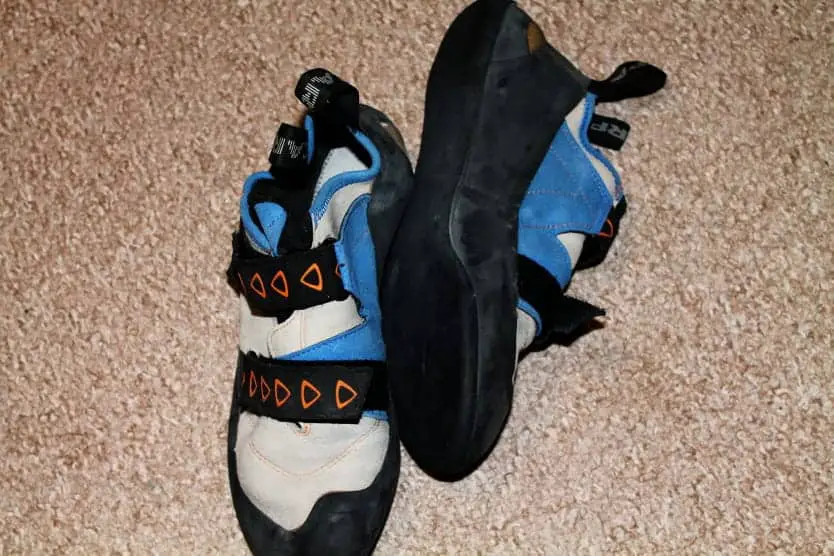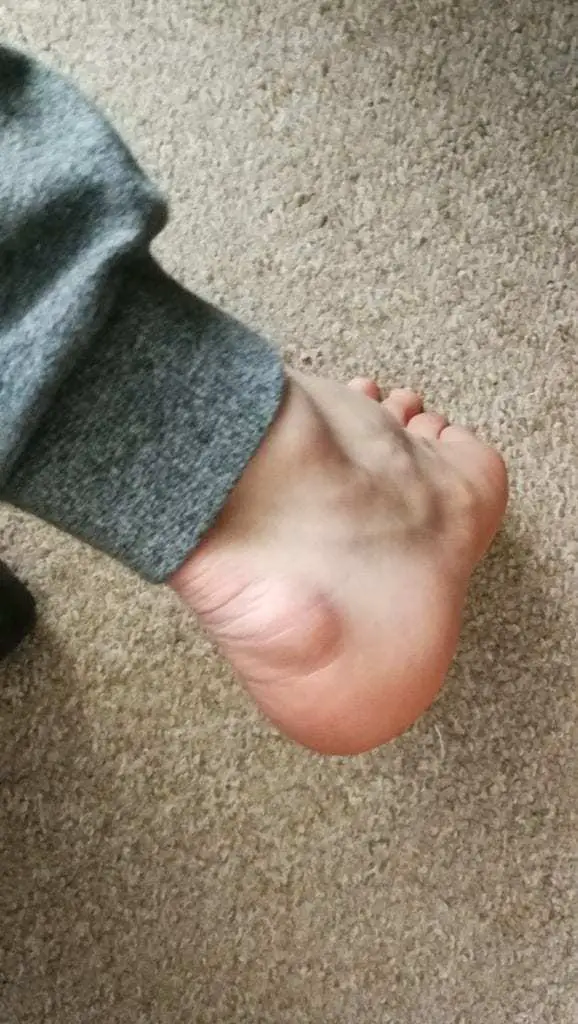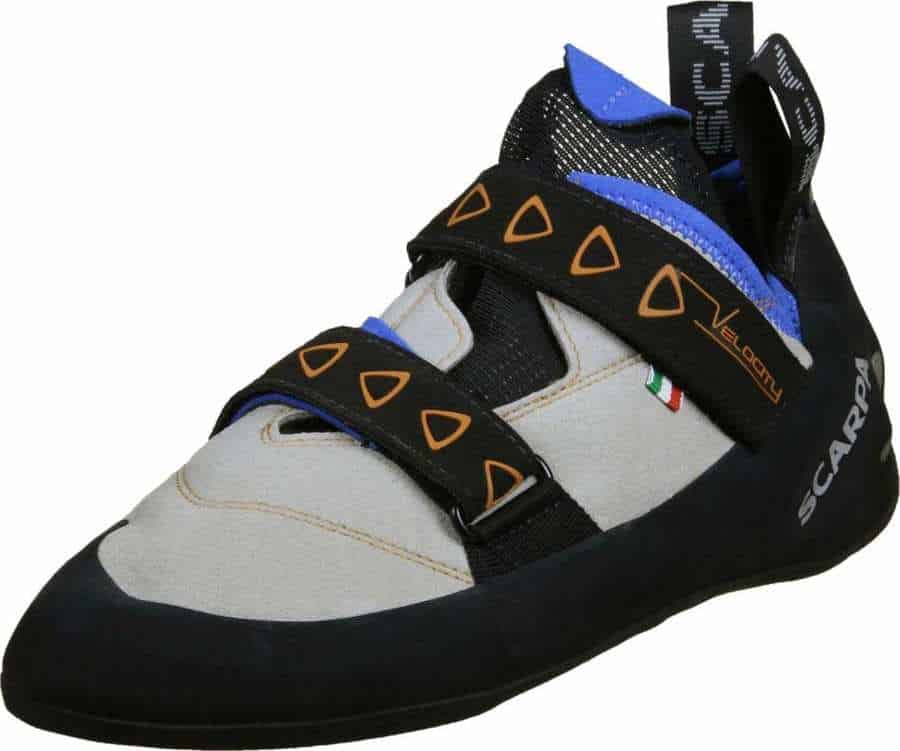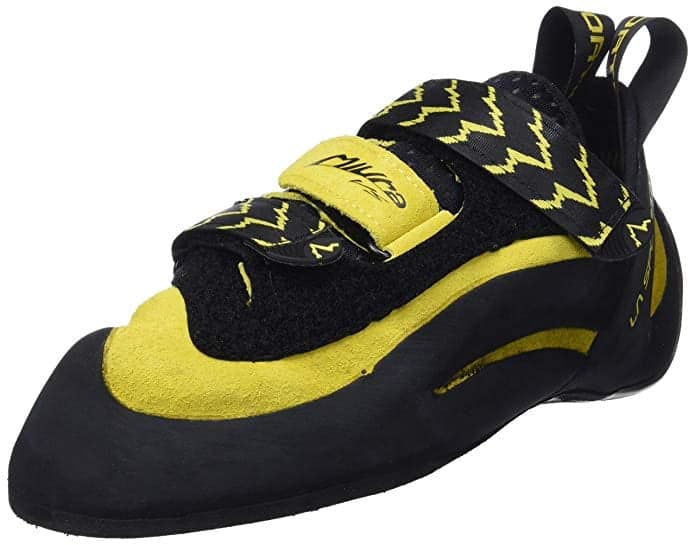
There have been many times on the climbing mats I’ve heard someone say “I’m in so much pain, my shoes are too small!” There could be many reasons for this, but there’s one thing that’s for sure: climbing shoes should not be painful when you wear them. At one point this was happening to me and it actually caused my right foot to develop a bunion on the heel and many other problems throughout my climbing journey. After researching why these problems occurred, I understood what I’d done wrong and how to choose the right size climbing shoes.
So, are your climbing shoes too small? If you are feeling pain when you’re wearing your climbing shoes then your climbing shoes are too small. Wearing uncomfortable climbing shoes is completely different to wearing painful climbing shoes.
If your climbing shoes are uncomfortable, that’s generally ok – this signifies that your toes and heels are usually snug inside your shoe providing a lot of sensitivity on the holds. However, if your shoes are painful, this is your body sending you a message that there is something wrong in that area which can lead to many different problems in the future such as bunions, chronic foot/toe pain such as metatarsalgia (pain in the ball of the foot), in-growing toe nails, and other conditions.
How can you choose the right size climbing shoe? The right size shoe can be found by trying climbing shoes on at certain times of the day and/or after going for a long walk or doing some other kind of exercise. It’s important to note that on hotter days your feet will swell up and therefore cause you more pain, so you may want to buy climbing shoes specifically for different seasons.
Keep reading for more information on how to choose the right climbing shoe, the conditions and injuries associated with wearing shoes that are too tight for you, and other related issues that may interest you.
Page Jumps
- How to Choose the Right Size Climbing Shoe
- Conditions and Problems that can be caused by Climbing Shoes that are too Tight
- Can you Stretch Climbing Shoes that are too Small?
- What Type of Climbing Shoe do You Need?
- Buy Climbing Shoes Depending on the Season
- Climbing Shoes with Laces, Velcro Strap or Slip-Ons
- Kids Climbing Shoes and Their Feet
- Climbing Shoe Information for People with Diabetes
- My Personal Foot Problems Due to Excessively Tight Climbing Shoes
How to Choose the Right Size Climbing Shoe
When you’re in the store trying on climbing shoes, you might find a pair that really suit your style of climbing and feel good to walk around in on the shop floor. Then you put them on and start climbing in them, only to realise you’ve made a grave error due to pain in your feet and can’t return them because of a no-return policy once they’ve been used on the wall. This has happened to me on occasion and I’ve got to say I’ve definitely learnt from it.
First off, we have to wonder why your shoes are ok when you wear them on the shop floor and they aren’t ok once you start climbing. It’s pretty simple, once you start climbing your feet swell up and therefore cause your shoes to feel tighter than they previously were. If they felt snug before, they’ll feel even more uncomfortable (or even painful) now. So how can we avoid this?
Well, there’s something you can do: go for a long walk or do some other sort of exercise that will encourage your feet to swell up before you buy your shoes. If you’re in your local climbing gym and you’re going to buy your shoes from there, it may well be a good idea to actually climb for a little bit with some old or rented shoes and then go and try some on in the shop. This will swell your feet up to the normal amount that would occur when you climb.
Now, the problem people seem to have when choosing a climbing shoe is how tight the shoe should be and how it should feel on your foot. This all depends on preference really, but it’s definitely recommended you wear shoes that aren’t painful but are snug enough on your heels and toes to be able to feel toe holds and other foot holds.
Some people prefer comfort over precision – this is why the La Sportiva Mythos (which is a classic climbing shoe) is bought frequently and is known as one of the most comfortable shoes on the market. However, some people sacrifice comfort for precision and sensitivity by buying other shoes like the Scarpa Furia Air specifically for bouldering.
If you have shoes that are very sensitive and precise but they are painful, this is most likely going to affect your climbing ability and may even cause problems for your feet, so you should probably sacrifice the precision of the shoe for comfort.
I’ve spent years finding out the shoes that work best for me. Before you decide on what climbing shoes you want, you might want to check out my recommendations.
Conditions and Problems that can be caused by Climbing Shoes that are too Tight
Here are the problems caused by tight climbing shoes. I’ve written another detailed article that describes how you can care for your feet before, after and while you climb.
Bunions
Climbers notoriously have more bunions than non-climbers, however bunions are thought to be hereditary in most cases but the condition can be helped along by pressure from your climbing shoe pushing against a joint in your foot. Bunions can be surgically removed; however there isn’t much point in doing this if you are going to repeat the process of climbing afterwards.
Often, bunions aren’t much of a problem, causing small amounts of pain here and there. I currently have a bunion on my heel caused by overuse of small rock climbing shoes – it doesn’t cause me many problems these days, however.

In-Growing Toe Nails
Shoes that are too small or too narrow can cause in-growing toe nails. In-growing toe nails can be very painful and very often cause infection around the nail which then causes the toe to become inflamed and swollen. It’s very hard to climb with an in-grown toe nail.
In-grown toe nails can be treated with surgery which is what I had to endure after I experienced an in-grown toe nail in my big toe due to an open fracture underneath the toe nail. Since then I’ve had many problems with my big toe such as the whole nail falling off and I experience a small amount of pain when climbing which could be caused by the open fracture I experienced in around 2012.
Metatarsalgia
Metatarsalgia is a condition in which an achy or sharp pain is felt around the ball of one’s foot. This condition is usually invisible to the naked eye; however the pain can be quite severe. If you believe you have metatarsalgia you should consult a podiatrist or your GP. It’s advised to use ice on the affected area and to rest it from the activities that aggravate it most.
Corns and Calluses
These can be very ugly to look at and cause infection if the wounds are open. Once infected they can be very painful. They are there to form a barrier against a shoe that’s too tight; so it’s pretty much your foot’s way to defend itself from friction and pressure. Unless your corns/calluses become infected, they are usually harmless and can be left alone. However, they are ugly to look at so you can buy a callus removing tool online which you can use at home to rid yourself of them.
Morton’s Neuroma
Morton’s neuroma is a condition that causes numbness, shooting or stabbing pain, and/or tingling in the foot which is sometimes relieved once you take off your tight climbing shoes. Some people explain the symptoms to be like feeling a stone is in your shoe even though there isn’t one.
It is believed to be caused by the plantar nerve in the foot becoming trapped by the transverse metatarsal ligament usually due to wearing footwear that is too tight.
Treating Morton’s neuroma can include ice, rest, over the counter painkillers, raise the affected foot when possible, and wear wider shoes with metatarsal pads/insoles. It isn’t advised to wear tight shoes or high heels if you have this condition.
Nail Bed Infection
Infections in the nail bed are usually caused by the attempted alleviation of pain of in-grown toe nails, again caused by the wrong size climbing shoe. When you trim your toe nails for climbing or if you ever try to alleviate the pain caused by an in-growing toe nail, please be careful that you don’t cut into the skin and open up a wound.
A few days after the next time you go climbing, you may find that your nail exudes a small (or large) amount of puss due to infection. It may also be quite painful. Infections can be treated by seeing your doctor for antibiotics. Putting your foot in salt water will also help heal the infection and reduce swelling/pain in the afflicted area.
Subungual Hematoma
I once had this condition – it sounds bad and looks pretty bad too but it’s not. You may find that the wrong size climbing shoes cause bleeding under your toe nail, especially after a session. It feels very painful to climb on and your toe nail looks like it’s bruised underneath. What’s usually happened is that you’ve got a blood blister underneath there and it’s popped causing a subungual hematoma. It’s not much to worry about, just try not to get it infected – treat it by putting your foot or toe in salt water for a good while every now and then.
Toe Deformities
Toe deformities are common in climbers. Many climbers have claw and hammer toes due to the shoes being tight and forcing them in a certain direction. Due to this, the foot starts to adapt and permanently shapes to the position the toes are in. There’s not much you can do about this if you’re a climber other than wear less tight shoes, however even snug shoes will probably deform your toes slightly.

Can you Stretch Climbing Shoes that are too Small?
Most parts of a climbing shoe are very hard to stretch permanently other than the upper part if it’s made of leather. Synthetic materials used on the upper parts of the climbing shoe are most likely created to not stretch, along with the very stiff rubber used on the soles and toe of the climbing shoe. Even if the upper is leather, the lining may be made of a synthetic material which cannot be stretched – this is the case with the La Sportiva Miuras.
The best way I’ve found to stretch the upper parts of climbing shoes that are actually able to be stretched is by putting your climbing shoes on while you’re in a hot shower. Continue to wear the shoes around the house for a while afterwards, leave to dry for a bit and then climb in your damp shoes a day or two later. This should hopefully stretch the uppers out. The upper part of the climbing shoe may not be your problem though, so this could be a waste of time.
You may just need to sell your climbing shoes on a local forum and buy some more shoes that fit properly by going through the process explained in this article above.
What Type of Climbing Shoe do you Need?
There are three types of climbing shoe you can get. These are neutral, moderate, and aggressive. It depends on your climbing capability as to what type of climbing shoe you should get. It also depends on the types of climbs you usually do.
Neutral
Neutral climbing shoes are great for beginners and climbers who climb V3 grades and below. They have a flat-ish surface on the sole and are usually quite comfortable. They can be worn all day without any problems. However, they aren’t as precise on toe holds as moderate or aggressive shoes.

Moderate
Moderate climbing shoes are good for intermediate climbers or climbers who need a better grip on toe holds. These shoes aren’t as comfortable as neutral shoes and usually aren’t as durable either.

Aggressive
Aggressive shoes are for the more advanced climber who needs the extra precision and sensitivity on toe holds and overhangs. They are not typically as comfortable as neutral shoes and moderate shoes, nor are they as durable.

Buy Climbing Shoes Depending on the Season
I have a set of laced climbing shoes specifically for the summer. They’re the same shoe I would usually wear just half a size bigger. This is because I know for a fact that my feet swell up to an almighty size when it’s hot. Having laces means I can control how tight the shoes are on my feet a lot easier than I could do with a Velcro strap.
I would definitely advise that you at least think about getting a second pair of shoes for summer/winter or factor in how far away the colder or hotter seasons are before you buy climbing shoes. If it’s already hot weather and you’re going to buy climbing shoes to fit correctly, you may want to think about how loose your shoes may be in colder weather. This is why I believe it’s best to have two pairs of shoes if you climb a lot in different temperatures.
Climbing Shoes with Laces, Velcro Strap or Slip-On
Laces
Laces are great for your all day climber who needs to loosen their shoes if their feet are too swollen or tighten their climbing shoe for the perfect fit and extra precision.
Velcro Strap
Velcro straps are great for taking off your shoes and putting them back on fast when bouldering without the need to take a lot of time tying laces. You can also loosen or tighten the strap for comfort/precision.
Slip-On
For maximum convenience regarding taking your shoes off and putting them back on as fast as possible, slip-on shoes are your go to. Slip-on shoes are great for climbing in small cracks due to how thin they make your foot.
Kids Climbing Shoes and Their Feet
It’s important to make sure you choose the right climbing shoes for your child. Their feet are very delicate compared to an adult because they’re still growing and developing. You don’t want to get your children climbing shoes that are too tight or painful as they may develop conditions in their feet that can’t be undone – these problems in their feet can then turn into problems in other areas of their body such as their spine (the feet and spine are very closely connected when it comes to injuries).
When you’re buying in the climbing store, get your child to try a pair of shoes on and ask them how their shoes feel. If they say they feel at all uncomfortable you should get them to try on a bigger size. You want your child to learn how to climb while developing in a healthy way. They don’t need to be 100% precise on the wall if that means they’re also going to develop problems with their body in the future due to the wrong size climbing shoe.
For more info on climbing with kids I’ve written a Bouldering for Kids and Toddlers article which you can find here.
Climbing Shoe Information for People with Diabetes
If you have diabetes you should not be wearing climbing shoes (or any footwear for that matter) that are too tight. Please consult your GP or doctor before you start climbing and ask for their advice.
My Personal Foot Problems Due to Excessively Tight Climbing Shoes
When I started climbing I was under the impression that your shoes needed to be as tight as possible to feel the toe holds on the wall. I was in pain every session but fought through it. Due to wearing excessively tight climbing shoes, I’ve developed a massive bunion on my foot, in-grown toe nails, nail bed infection, a subungual hematoma which also caused my big toe nail to fall off, and general foot/toe pain. I can also see quite a bit of toe deformity on most of my toes.
If I could go back in time and tell my former self what to do I’d let myself know that it’s better to be in snug shoes that feel slightly uncomfortable than in lots of pain. Not only do you climb a lot better due to the fact you aren’t grimacing on every toe hold you plant your foot on, you’re also having a lot more fun climbing.
